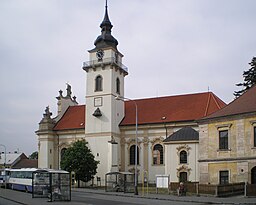Heřmanův Městec
| Heřmanův Městec | |||
| Town | |||
|
Saint Bartholomew Church
|
|||
|
|||
| Country | Czech Republic | ||
|---|---|---|---|
| Region | Pardubice | ||
| District | Chrudim | ||
| Commune | Chrudim | ||
| Municipality | Heřmanův Městec | ||
| Elevation | 280 m (919 ft) | ||
| Coordinates | 49°56′51″N 15°40′5″E / 49.94750°N 15.66806°ECoordinates: 49°56′51″N 15°40′5″E / 49.94750°N 15.66806°E | ||
| Area | 14.34 km2 (5.54 sq mi) | ||
| Population | 4,822 (2014-01-01) | ||
| Density | 336/km2 (870/sq mi) | ||
| First mentioned | 1325 | ||
| Mayor | Aleš Jiroutek | ||
| Timezone | CET (UTC+1) | ||
| - summer (DST) | CEST (UTC+2) | ||
| Postal code | 538 03 | ||
| Statistics: statnisprava.cz | |||
| Website: www.hermanuv-mestec.cz | |||
Heřmanův Městec (Czech pronunciation: [ˈɦɛr̝manuːf ˈmɲɛstɛts]; German: Hermanmiestetz, Hermannstädt(e)l) is a town in Pardubice Region of the Czech Republic. Located at the northern foothills of the Iron Mountains (about 10 km west of Chrudim and 87 km east of Prague) at an altitude of 275 meters above sea level. In 2017, it has about 4,800 residents.
Jews were living in Heřmanův Městec as early as the first half of the 15th century and it represents one of the oldest documented Jewish communities in the Chrudim District. A minyan (10 adult Jewish males) was recorded as early as 1570. The Jewish community continued to grow and thrive over the years. During the Hapsburg repression of the Jews, the town had a Jewish ghetto.
Eventually, Heřmanův Městec became the seat of the district rabbi. The Jewish population peaked in 1849 at 840 and began to decline as both Jews and non-Jews left rural areas to pursue employment in cities as part of the industrial revolution. During the occupation by Nazi Germany during World War II, most of the approximately 60 remaining Jews were deported to the Tereźin concentration camp in December 1942. Few survived the war and the Jewish community was effectively destroyed. In 2001, through the efforts of the local inhabitants, the Jewish cemetery was restored along with the Synagogue and rabbi’s home which now serve as a cultural center.
The town was the property of a series of aristocratic landowners who enjoyed a mostly positive relationship with the Jewish community. The Jewish community paid a fixed annual sum of money to the landowning gentry. During the 16th, 17th, and 18th centuries, Jews living in the town were mainly engaged in trade (linen, wool, hides, or feathers) and money-lending. The location of the town along the road connecting Prague with Moravia brought a great number of merchants into the area. A Jewish settlement grew up on single street (now Havlickova Street) which eventually had its own mayor, police, and other officials.
According to oral tradition, the Jewish cemetery in town dates back to the 1430. Usually, when Jews move into an area, one of their first community actions is to purchase land for a cemetery. There is documentation from 1667 that additional land was purchased for the purpose of enlarging the Jewish cemetery. There are records of additional extensions that took place in 1685, 1709, 1723 and 1838. The cemetery eventually reached almost 4,000 square meters. In 1643, the Jewish community united to form a Chevra Kadisha (or burial society). The date of the construction of the first synagogue is unclear, but it was destroyed in a large town fire in 1623.
...
Wikipedia





